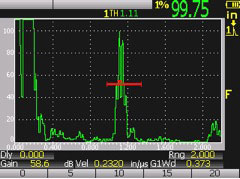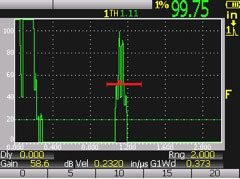3.5 Display Formats
A-scan display
Any ultrasonic instrument typically records two fundamental parameters of an echo: how large it is (amplitude), and where it occurs in time with respect to a zero point (pulse transit time). Transit time in turn is usually correlated to reflector depth or distance, based on the sound velocity of the test material and the simple relationship distance = velocity x time.
The most basic presentation of ultrasonic waveform data is in the form of an A-scan, or waveform display, in which echo amplitude and transit time are plotted on a simple grid with the vertical axis representing amplitude and the horizontal axis representing time. This is the standard format for echo presentation in ultrasonic flaw detection. The example below shows a version with a rectified waveform; unrectified RF displays are also used. The red bar on the screen is a gate that selects a portion of the wave train for analysis, typically measurement of echo amplitude and/or depth.
B-scan display
Another way of presenting this information is as a single value B-scan. A B-scan format is commonly used with conventional flaw detectors and corrosion thickness gages to plot the depth of reflectors with respect to their linear position. The thickness is plotted as a function of time or position while the transducer is scanned along the part to provide its depth profile. Correlating ultrasonic data with actual transducer position allows a proportional view to be plotted and allows the ability to correlate and track data to specific areas of the part being inspected. This position tracking is typically done through the use of electromechanical devices known as encoders. These encoders are used in fixtures which are either manually scanned or in automated systems that move the transducer by a programmable motor-controlled scanner. In either case the encoder records the location of each data acquisition with respect to a desired user-defined scan pattern and index resolution.
In the case below, the B-scan shows two deep reflectors and one shallower reflector, corresponding to the positions of the side drilled holes in the test block.
Special A-scan functions
Freeze: A Freeze function is used to freeze a real time screen display for further analysis, during which the transducer may be removed from the test piece. Many digital flaw detectors permit adjustment of some display, setup, and measurement parameters while the screen is frozen.
Peak Memory: A peak memory function captures and stores on the screen the amplitude of each display point and updates each pixel if a signal of greater amplitude is acquired. The result is a display of the peak amplitude envelope superimposed on the live waveform. Peak memory is useful for capturing flaw indications when scanning a test piece, and for capturing the peak response from a reflector during angle beam inspections. For example, in the video above a transducer is scanned across a five-step test block and the instrument records the echo from each step as it goes by.
Peak Hold: A Peak Hold function is similar to peak memory except that it represents a one-time screen capture that does not update even if the live waveform exceeds the stored peak. It is typically used to compare a live waveform to that from a reference standard.
Reject: A Reject function eliminates unwanted low level signals from the A-scan display, which can reduce baseline noise and provide a cleaner picture. However some test codes prohibit the use of reject since it can also mask small flaw indications. In the example below, a 20% reject level (marked by the horizontal green line) is used to eliminate grain scatter noise in a casting test.
 Reject off (0%) |  Reject on (20%) |